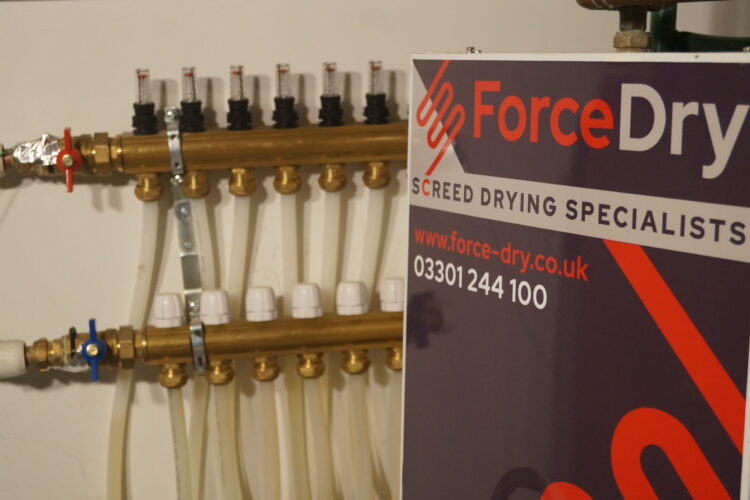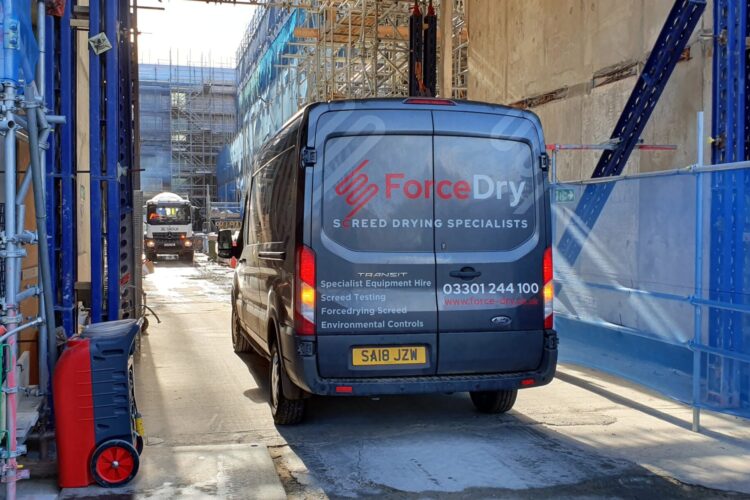What is ForceDrying?
The Natural Process
Without a force drying process flowing screeds naturally dry at 1mm per day for the first 40mm then 0.5mm per day thereafter. 50mm screed would take at least 60 days to dry naturally and would require a further 17 days to complete a Commissioning and Conditioning cycle before the floors can be laid.
Manufacturers typically calculate drying times based on an air temperature of 20°c with a relative humidity level of 65%, 24 hours a day, 7 days a week for 60 consecutive days. In the UK these temperatures and humidity levels are very rare so natural drying of screed often takes longer unless force drying is applied.
Flooring contractors will usually specify the Relative Humidity and conditions the screed needs to meet before laying the floor finishes and therefore they need to be monitored and managed closely.
There are several key factors involved in how quickly flooring may be applied to a screed:
- Temperature of the room – lower temperatures will increase drying time.
- Humidity of the room – higher air humidity will increase drying time.
- The batch/consistency of the screed.
- The use of retarders – retarders added to the screed at a batching plant or in volumetric mixers will severely affect drying of the screed.
- Dryness requirements of the flooring – most flooring products require a screed surface relative humidity of ˂ 75% for application. Bonded wood floorings generally require a considerably lower moisture content, this can be tested using several methods.
Force Drying
The force drying process can combat these head on, by creating an ideal environment so decreasing the drying time, (i.e., 20°c and a relative humidity of 65%). If there is no under-floor heating, simply introducing space heaters to increase the ambient temperature of the room, adding air moving fans and dehumidifiers to circulate and remove the moisture will effectively reduce the drying time of the screed. If there is under floor heating this can be utilised to carry out a force drying programme. If the under-floor heating is functional, this can be used. If not, ForceDry can provide specialist temporary boilers. Both methods can be used to slowly heat the screed with the help of air moving fans and dehumidifiers to destratify the air and remove the moisture. This process can be run over 21 days (depending on the specification of the type, brand, and thickness of the screed) to effectively force dry the screed ready for floor finishes to be installed.
The stages of Force Drying
- Prior to pouring screed
- Slump Test screed product prior to the pour and record results.
- Pour screed and ensure area is protected from rapid drying (draughts/heat) for the first 48-72 hours.
Light foot traffic only after 48hours.
4 days after pouring screed
- Sand floors to remove laitance.
- Manage environmental limitations by removing dust, sealing doors, windows etc in order to aid the drying process.
- Introduce ForceDry dehumidifiers (for Anhydrite this is typically 4 days after pouring screed, check with your screed manufacturer). Ensure they can empty moisture into either a drain point or container. Consider using a drip tray under catchment tank.
- Carry out Moisture test to establish the relative humidity 0-100%, record results. Test using an Air Hygrometer, Tramex meter, Protometer, Carbide Bomb Test (destructive method).
7 days after pouring screed
Day 1 of Force Drying
- Introduce ForceDry Boilers beginning at 20 degrees (or the lowest manifold temperature).
- Continue to manage Dehumidifiers and ensure they drain.
Day 2
- Increase the ForceDry boiler temperature by 5 degrees and continue to do so every 24hrs until 50 degrees is achieved.
- 40mm-50mm screed typically takes 7 days to achieve this temperature. Deeper screed such as 75mm will take longer.
- 40mm-50mm screed – Once at 50 degrees HOLD for 7 days.
- 75mm screed – Once at 50 degrees HOLD for 14 days. Depending on screed type, the hold length my vary
Day 14
For 40mm-50mm screed, having completed the 7 day HOLD.
- Every 24hrs decrease the ForceDry boiler temperature by 5 degrees until 20 degrees is achieved.
- For 40mm-50mm screed this typically takes 7 days to return to this temperature.
For thicker screed such as 75mm it will take a few more days to reach this stage.
Once the hold period has been complete for thicker screed, the same steps apply.
Day 21
- For 40mm-50mm screed the drying cycle is typically complete.
- For thicker screed it will take a few more days to reach this stage.
An example of a Force Drying programme for a 50mm screed floor might look something like this:

Related Blog Posts




